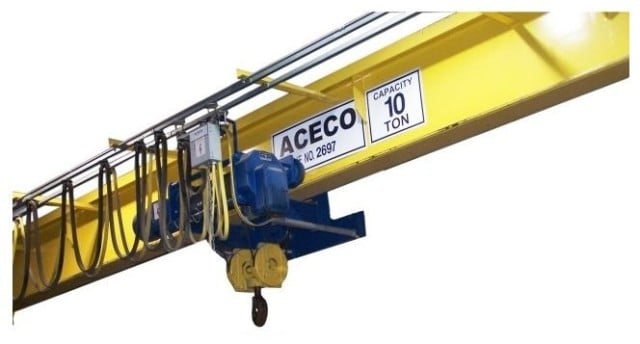Overhead Crane Systems
Optimizing productivity, safety, and space savings, overhead material handling solutions allow for easy lifting and moving in industrial facilities. Safely transporting products overhead, these cranes free up precious floor space, eliminate the need for inconvenient lane closures, and reduce the risks of product damage and worker injury.
Overhead cranes provide an ergonomic way to move loads that would otherwise be difficult or awkward to configure. They are also built to handle critical loads — from high-value equipment to containers of harmful chemicals — and are thoroughly tested to ensure optimal performance.
Overhead Crane Systems and Components
Depending on the specific application and load capacity, the following crane systems can range in size, complexity, and operation. Regardless of style, however, there are three universal parts for overhead cranes:
- Bridge: The bridge is comprised of stationary or mobile rails that form a parallel runway to carry one or more trolleys across it.
- Trolley: Running side to side across the bridge, this unit carries the hoist.
- Hoist: The hoist is the mechanical device that hooks onto the load to raise it. Hoists can also be used independently for vertical lifting applications. The most common type, electric hoists, use single-, double-, and variable-speed electric motors to lift capacities ranging from 250 pounds to several hundred tons.
The largest capacity overhead cranes are top-running, double-girder cranes. Traveling on top of two parallel girders, these cranes offer maximum headroom and lifting height, carrying capacities upward of 600 tons. For hard-to-reach applications, monorail overhead lifting systems can be installed directly into the roof as a route network or single circuit.
CMAA Crane Classifications
The Crane Manufacturers Association of America (CMAA) has identified six different crane classifications, determined by duty cycle capabilities.
- Class A — Standby or infrequent service
- The lightest duty cycle, encompassing cranes that handle loads very precisely, at slow speeds, with long or frequent periods of downtime
- Examples: transformer or utility stations
- Class B — Light service
- Includes cranes performing only a handful of light lifts per hour, traveling short distances (averaging about 10 feet) at slow speeds
- Examples: repair shops and light assembly operations
- Class C — Moderate service
- Cranes that handle loads averaging 50% of the rated capacity with 5-10 lifts per hour, traveling about15 feet; no more than 50% of lifts are at rated capacity
- Examples: machine shops and paper mill machine rooms
- Class D — Heavy service
- Includes cranes constantly carrying loads nearing 50% of the rated capacity at high speeds, making about 10-20 lifts across an average of 15 feet per hour; no more than 65% of lifts are at rated capacity
- Examples: heavy machine shops, lumber mills, steel warehouses, and foundries
- Class E — Severe service
- Includes cranes that can handle 20 or more lifts per hour with loads constantly nearing the rated capacity
- Examples: magnets and buckets for scrapyards and mills
- Class F — Continuous severe service
- Refers to cranes capable of continuously lifting loads at or near rated capacity under severe service conditions
- Examples: usually custom-designed specialty cranes in production facilities
American Crane’s Offerings and CMAA Categories
American Crane & Equipment Corporation (ACECO) manufactures all our cranes and overhead lifting solutions to stringent quality requirements — meeting even the most demanding CMAA category specifications.
Our selection includes multiple-girder cranes available in duty classes A through F, single girder cranes in duty classes A through D, and jib cranes in duty classes A through F.
As an industry-leading crane and material handling solutions manufacturer, American Crane can custom design and build a system to meet the needs of your specific application, as well as rebuild existing equipment. We also stock quality overhead crane parts from esteemed brands to ensure you have the replacement parts you need to get back up and running as soon as possible.
Our in-house crane solutions experts are available to address any questions you may have about overhead crane maintenance, crane systems, or replacement parts. Contact our team today for more information.


